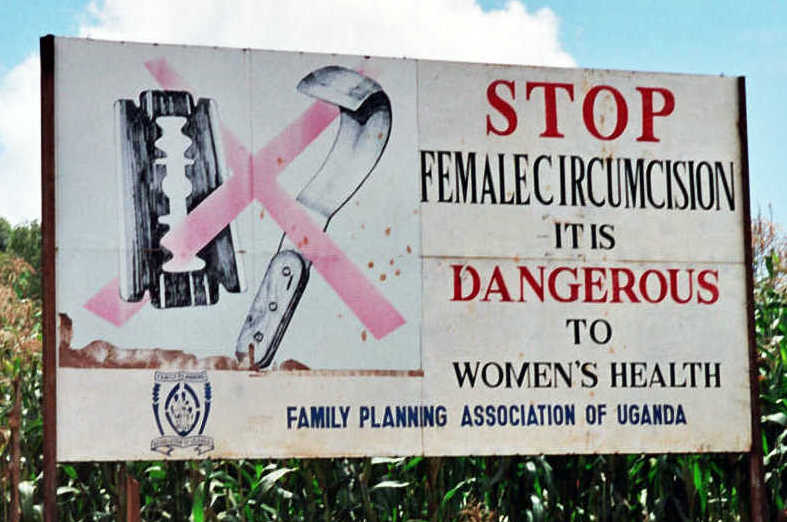The World Health Organization has released new guidelines on care for women who have been subjected to genital mutilation (FGM). This is an effort to bring medical standardization to an extremely complicated – and controversial – topic. Female genital mutilation involves cutting, scarring, or removing all or part of a woman’s external genitalia without a medical reason to do so. It takes place in 30 countries in Africa and a few in Asia and the Middle East.
As one might expect, there a lot of very strong opinions on the subject. Even the language around the topic is cause for debate. The term “female genital mutilation,” is questioned by many. Some activists and global health scholars prefer the more emotionally neutral term “female genital cutting,” recommended by an anthropologist at the University of Washington. Others even refer to it as “female circumcision,” creating a sense of equivalence to male circumcision, which has a beneficial effect in reducing the transmission of HIV. (The WHO’s preferred description, “woman who have been subject to FGM,” does seem to reduce women’s agency in the topic.)
It gets much more complex. FGM is performed almost entirely by women on the decision of mothers or the women themselves; does working to end the practice therefore also harm women’s status and autonomy by ignoring their wishes? Most of the debate, however, is over how to best bring an end to the practice. Does making the practice illegal reduce social acceptance, or simply cause it to be performed in more dangerous circumstances? Should medical professional be trained to perform it safely and with minimal harm, or should they face legal action for being involved?
This new release from WHO takes a firm stand against the practice, and against having it performed by medical professionals. The policy recommendations by WHO which can be summarized as: 1) FGM is harmful to women and girls 2) Everyone, at the community, national, regional and international level – should seek to prevent FGM and 3) Performance of FGM by health-care providers) is never acceptable because this violates medical ethics.

But What Happens if a Woman Has Been Cut?
These new care guidelines seek to minimize the health impact of FGM upon the women who has been subject to it. They begin by defining the four types of FGM and go on to discuss the best treatment options for women who have been subjected to the different types FGM. The types of FGM vary substantially, and they make a difference to decision-making around treatment.
While the guidelines themselves are technical and aimed at health care providers, the description of the four types of FGM puts the practice into clear perspective: (Now would be a good time for a content warning; these are detailed descriptions of harm done to women’s genitalia.)
Type I: “Partial or total removal of the clitoris (clitoridectomy) and/or the prepuce” (cutting or removing the clitoris and the fleshy part around it)
Type II: “Partial or total removal of the clitoris and the labia minora, with or without excision of the labia majora (excision)” (cutting or removing the clitoris and all the folds around the clitoris and possibly scarring the outer labia)
Type III: “Narrowing of the vaginal orifice with the creation of a covering seal by cutting and appositioning the labia minora and/or the labia majora, with or without excision of the clitoris (infibulation)” (Making the vagina hole smaller by sewing the labia closed over it and possibly also removing the clitoris)
Type IV: “Type IV All other harmful procedures to the female genitalia for non-medical purposes, for example: pricking, pulling, piercing, incising, scraping and cauterization” (catchall for everything from clitoral piercing to deliberate scarring)
The WHO summarizes best practices for treatments in a set of bullets:
- “de-infibulation to prevent and treat obstetric complications, as well as to facilitate childbirth, and prevent and treat problems with the urinary tract system;” (de-infibulation is increasing the size of a vaginal opening which has been sealed shut)
- “mental health including cognitive behavioral therapy and psychological support to treat depression and anxiety disorders;”
- “female sexual health covering sexual counselling to prevent or treat female sexual dysfunction;”
- “information and education for all women and girls who have undergone female genital mutilation, and health education and information on de-infibulation, where appropriate, for both health-care providers and for women and girls.”
The guidelines go into more detail on when precisely to perform de-infibulation and why it is called for, but what really stands out is the focus on mental health.
Three of the four recommended practices focus on mental and emotional well-being. While this is a recognition of the important of mental health, it is also a grim reminder that many of the physical impacts of FGM have no medical solution. For example, the guidelines make no recommendations for the treatment of pain in the vulva or clitoris, because there is no proven treatment for it. They also do not recommend clitoral reconstruction, because the failure rate is unacceptably high. Women who have been subjected to FGM live with the consequences, and it seems that right now the best we can do is provide the mental health support for them.
What the Guidelines Don’t Say
They don’t address the social or cultural constructs around FGM, but as medical guidelines they are not intended to. As mentioned, the paucity of effective medical solutions means they have little to offer on the subject of pain in the clitoris or vulva. In the discussion section, they best that can offer is that women should avoid activities like riding a bicycle that put pressure on the region.
One Sentence Takeaway
Female genital mutilation harms women and the medical options for reducing that harm are very few.
